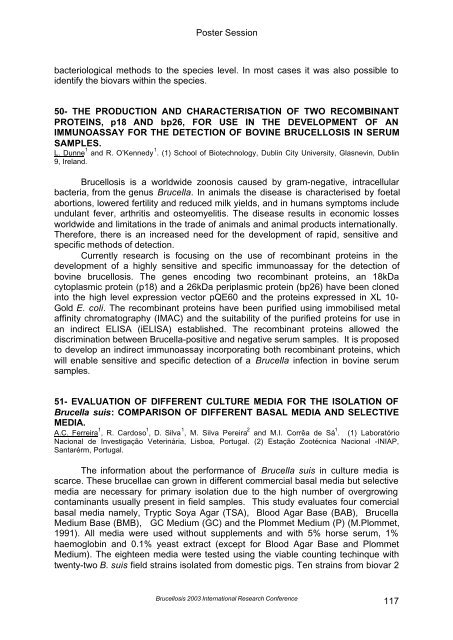Brucellosis 2003 proceedings - PHIDIAS
Brucellosis 2003 proceedings - PHIDIAS
Brucellosis 2003 proceedings - PHIDIAS
You also want an ePaper? Increase the reach of your titles
YUMPU automatically turns print PDFs into web optimized ePapers that Google loves.
Poster Session<br />
bacteriological methods to the species level. In most cases it was also possible to<br />
identify the biovars within the species.<br />
50- THE PRODUCTION AND CHARACTERISATION OF TWO RECOMBINANT<br />
PROTEINS, p18 AND bp26, FOR USE IN THE DEVELOPMENT OF AN<br />
IMMUNOASSAY FOR THE DETECTION OF BOVINE BRUCELLOSIS IN SERUM<br />
SAMPLES.<br />
L. Dunne 1 and R. O’Kennedy 1 . (1) School of Biotechnology, Dublin City University, Glasnevin, Dublin<br />
9, Ireland.<br />
<strong>Brucellosis</strong> is a worldwide zoonosis caused by gram-negative, intracellular<br />
bacteria, from the genus Brucella. In animals the disease is characterised by foetal<br />
abortions, lowered fertility and reduced milk yields, and in humans symptoms include<br />
undulant fever, arthritis and osteomyelitis. The disease results in economic losses<br />
worldwide and limitations in the trade of animals and animal products internationally.<br />
Therefore, there is an increased need for the development of rapid, sensitive and<br />
specific methods of detection.<br />
Currently research is focusing on the use of recombinant proteins in the<br />
development of a highly sensitive and specific immunoassay for the detection of<br />
bovine brucellosis. The genes encoding two recombinant proteins, an 18kDa<br />
cytoplasmic protein (p18) and a 26kDa periplasmic protein (bp26) have been cloned<br />
into the high level expression vector pQE60 and the proteins expressed in XL 10-<br />
Gold E. coli. The recombinant proteins have been purified using immobilised metal<br />
affinity chromatography (IMAC) and the suitability of the purified proteins for use in<br />
an indirect ELISA (iELISA) established. The recombinant proteins allowed the<br />
discrimination between Brucella-positive and negative serum samples. It is proposed<br />
to develop an indirect immunoassay incorporating both recombinant proteins, which<br />
will enable sensitive and specific detection of a Brucella infection in bovine serum<br />
samples.<br />
51- EVALUATION OF DIFFERENT CULTURE MEDIA FOR THE ISOLATION OF<br />
Brucella suis: COMPARISON OF DIFFERENT BASAL MEDIA AND SELECTIVE<br />
MEDIA.<br />
A.C. Ferreira 1 , R. Cardoso 1 , D. Silva 1 , M. Silva Pereira 2 and M.I. Corrêa de Sá 1 . (1) Laboratório<br />
Nacional de Investigação Veterinária, Lisboa, Portugal. (2) Estação Zootécnica Nacional -INIAP,<br />
Santarérm, Portugal.<br />
The information about the performance of Brucella suis in culture media is<br />
scarce. These brucellae can grown in different commercial basal media but selective<br />
media are necessary for primary isolation due to the high number of overgrowing<br />
contaminants usually present in field samples. This study evaluates four comercial<br />
basal media namely, Tryptic Soya Agar (TSA), Blood Agar Base (BAB), Brucella<br />
Medium Base (BMB), GC Medium (GC) and the Plommet Medium (P) (M.Plommet,<br />
1991). All media were used without supplements and with 5% horse serum, 1%<br />
haemoglobin and 0.1% yeast extract (except for Blood Agar Base and Plommet<br />
Medium). The eighteen media were tested using the viable counting techinque with<br />
twenty-two B. suis field strains isolated from domestic pigs. Ten strains from biovar 2<br />
<strong>Brucellosis</strong> <strong>2003</strong> International Research Conference<br />
117
















